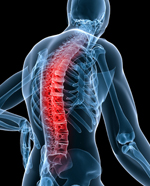 |
Anterior endoscopic foraminotomy
Enterior endoscopic foraminotomy is a revolutionary technique that allow us to approach the pathology without necessitating cervical fusion. With this technique, decompression of the nerve root and spinal cord is performed through a narrow tunnel on the side of the intervertebral disc without the need to remove it and fuse the spine. This will keep the spine motion intact and even improve it after the bone spurs removal. There is no need for cervical brace after the surgery. Post operation X-rays films proved the spine stability. Hospitalization is only for one day and recovery period is short. Preservation of the intervertebral disc is essential for neck motion. Even if the disc looks degenerated on CT or MRI images, it still has an import role in harmonic neck motion.
Anatomy of the cervical spine The cervical spine is composed of seven vertebra and create the spinal canal, where the spinal cord pass through. The spinal cord transmits signals from the brain to the arms, legs and body. It also transmits sensory signals of touch, pain and position sense from the body to the brain. The spinal cord is important for bladder and sexual function. The nerve root leaves the spinal cord through the intervertebral foramen or hole on each level and on each side. The nerve root is numbered by the level, for example: C6 nerve root leaves the spinal canal between C5 and C6 vertebra. Pathology of the cervical spine (degenerative) Spinal stenosis and or foraminal stenosis can be caused by spondylotic ostephytes or disc herniation. In some cases there is ossification of the posterior longitudinal ligament (OPLL) which can cause severe spinal stenosis. Symptoms
A) Radiculopathy which is caused by compression of the nerve root. It may cause pain or numbness to the neck, scapula or arm. In more advanced cases it may cause muscle weakness and atrophy (waste). Sometime the pain from the neck can radiate to the head. B) Myelopathy which is the cause of spinal cord compression with weakness and numbness in arms and legs and difficult coordination. It can also cause urinary frequency and sexual dysfunction. Indications for surgery A) Radiculopathy: Intolerable arm, scapula or neck pain or numbness with or without weakness. B) Myelopathy: with weakness or numbness in arms and legs. There are early signs of myelopathy with hyper-reflexive lower and/or upper extremities and gait instability. Unilateral spinal cord compression can imitate nerve root symptoms. C) Cervical MRI (CT myelogram for those who can’t perform the MRI due to medical reason) that correlates with the symptoms. D) EMG- sometime useful. |






